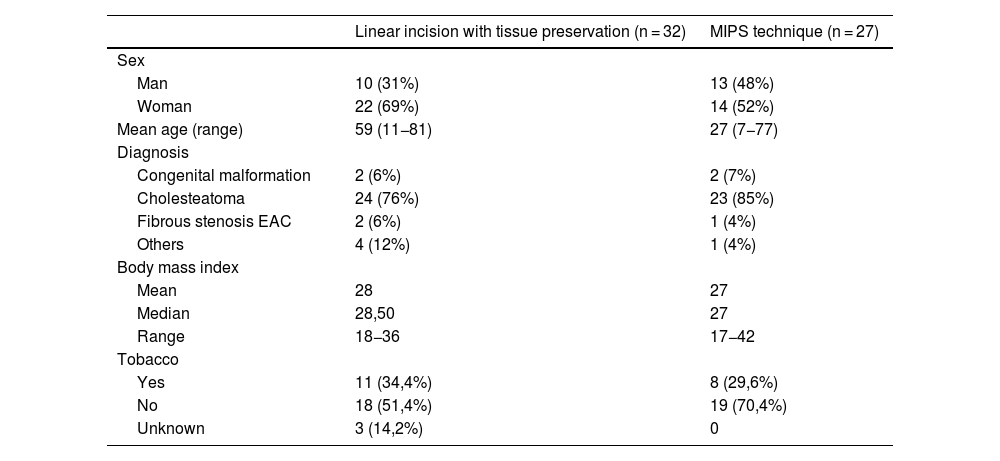The surgery of osseointegrated implants has undergone different modifications over the years with the aim of achieving better results and facilitating the surgical technique. Today the most commonly used technique is the linear incision with tissue preservation and placement of the abutment and implant. The long-term success of this technique has served as the basis for the development of the so-called minimally invasive surgical approach (MIPS). This study compares the short-, medium- and long-term results between the classic linear incision technique and the MIPS technique.
Material and methodsA prospective study was conducted on patients who had an osseointegrated implant placed between February 2016 and February 2020. A total of 59 surgeries were performed, 32 surgeries according to the linear incision technique with tissue preservation and 27 with MIPS technique. Outcomes were evaluated at one week, one month and one year.
ResultsStatistically significant differences were achieved between the 2 groups at one week after surgery. Eighty per cent of the MIPS patients had Holgers grades 0–1 compared to 35% of the linear technique patients (p = 0.001). No statistically significant differences were observed at one month (p = 0.457) and one year (p = 0.228). One case with grade 4 was recorded which resulted in implant extrusion one month after surgery with the MIPS technique. A new osseointegrated implant was placed 2 months after the fall using the same MIPS technique with good results. We were also able to verify that the duration of surgery was much shorter with the MIPS technique and better tolerated in terms of postoperative discomfort by the patient.
ConclusionsIn our experience, the MIPS technique is the technique of choice for surgery of osseointegrated Ponto model implants as it is simpler, faster and presents fewer problems in the immediate postoperative period, with similar long-term postoperative results.
La cirugía de los implantes osteointegrados ha sufrido distintas modificaciones a lo largo de los años con el objeto de lograr mejores resultados y facilitar la técnica quirúrgica. Hoy en día la técnica más utilizada es la de la incisión lineal con preservación de tejidos y colocación del pilar e implante. El éxito a largo plazo de esta técnica ha servido de base para el desarrollo del conocido como método quirúrgico mínimamente invasivo (MIPS). En este estudio se comparan los resultados a corto, medio y largo plazo, entre la técnica clásica de incisión lineal y la técnica MIPS.
Material y métodosSe realizó un estudio prospectivo de pacientes a los que se les ha colocado un implante osteointegrado entre febrero de 2016 y febrero 2020. Se realizaron un total de 59 cirugías, 32 cirugías según la técnica de incisión lineal con preservación de tejidos y 27 con técnica MIPS. Se evaluaron los resultados a la semana, al mes y al año.
ResultadosSe alcanzaron diferencias estadísticamente significativas entre los 2 grupos a la semana de la intervención. El 80% de los pacientes a los que se realizó la técnica MIPS presentaban grados 0–1 de Holgers frente al 35% de los pacientes con técnica lineal (p = 0,001). No se observaron diferencias estadísticamente significativas al mes (p = 0,457) y al año (p = 0,228). Se registró un caso con grado 4 que desembocó en la extrusión del implante al mes de la cirugía con la técnica MIPS. Se colocó nuevo implante osteointegrado a los 2 meses de la caída utilizando la misma técnica MIPS con buen resultado. También pudimos comprobar que la duración de la cirugía era mucho menor con la técnica MIPS y mejor tolerada en cuanto molestias postoperatorias por el paciente.
ConclusionesEn nuestra experiencia, la técnica MIPS es la técnica de elección para la cirugía de los implantes osteointegrados modelo Ponto por ser más sencilla, más rápida y presentar menos problemas en el postoperatorio inmediato, con resultados postoperatorios similares a largo plazo.











